UPSC GS 1
Karma Festival
- News: Tribal populations in Jharkhand, West Bengal, Bihar, Madhya Pradesh, Chhattisgarh, Assam, and Odisha celebrated the harvest festival of Karma or Karam Parv recently.
- Definition:
-
- Karma Puja is celebrated in Jharkhand, Bihar, Assam, Chhattisgarh, Madhya Pradesh, Jhargram (West Bengal) and many other states.
- The festival is especially popular among tribes like the Munda, Ho, Oraon, Baiga, Kharia, and Santhal.
-
- Karam Tree:
-
- On this day people pray to Karam Devta to get the blessings.
- At the heart of the festival is the Karam tree, a symbol of Karam Devta or Karamsani, the god of strength, youth, and vitality.
- The festival is named after this sacred tree, which plays a central role in the celebrations.
-

- Time of Celebration:
-
- The festival is traditionally celebrated on the Ekadashi tithi (eleventh day) of the lunar fortnight in the month of Bhado/Bhadra.
- This period falls in August-September, according to the Gregorian calendar.
-
- Rituals Associated with the Karam Tree:
-
- A week before the festival, young women bring clean river sand and sow seven types of grains in it.
- On the day of the festival, a branch of the Karam tree is planted in the courtyard or ‘akhra’.
- Devotees offer jawa (hibiscus) flowers, and the pahan (priest) worships the Karam Raja.
- At the same time, the unmarried tribal girls celebrate the Jawa festival, which has its own kind of songs and dance.
- The girls offer green melons to the Karam deity as a symbol of ‘son’ which reveals the primitive expectation of human being (i.e., grains and children).
- Traditional dancing and singing follow the worship rituals.
-
- Immersion of the Karam Branch:
-
- The festival concludes with the immersion of the Karam branch in a river or pond.
- Jawa (hibiscus flowers) are distributed among the devotees as prasad.
- In some regions, branches from sal or bhelua trees are planted in fields with hopes of protection for crops by the Karam Devta.
-
- The Myth of the Seven Brothers:
-
- An origin myth from Odisha tells of seven brothers who neglected to worship Karamsani, resulting in their health deteriorating, their fields withering, and their cattle falling sick.
-
- Connection to Agriculture:
-
- According to Parwati Tirkey, the festival’s origin is linked to the beginning of agriculture by tribal communities.
- As the Oraon/Kurukh people started clearing forests for cultivation, they aligned their cultural practices with the agricultural cycle.
- The festival coincided with the autumn rains and the watering of paddy fields, marking the season of dhaan (grains).
-
- Natural Insecticide Practices:
-
- During the Karam festival, along with the Karam branch, the Oraon community plants stems of Chirchitti (chaff flower) and Sindwar (chaste tree) in paddy fields.
- These plants act as natural insecticides, protecting the crops from pests.
-
Read also: Food vs Cars Dilemma: Balancing Sustainability & Mobility | UPSC
Periyar EV Ramasamy
- News: Rationalist social reformer Periyar EV Ramasamy was remembered on the occasion of his 146th birth anniversary in Chennai on September 17.
- Early Life and Political Beginnings:
-
- Periyar was born in 1879.
- Periyar began his political career as a Congress worker in his hometown, Erode.
- He is known as the Father of the Dravidian movement.
-
- Political Involvements:
-
- Periyar had a disagreement with Gandhi over the issue of separate dining for Brahmin and non-Brahmin students at Gurukkulam, a Congress-sponsored school in Cheranmahadevi.
- After failing to change Congress’s stance, Periyar resigned from the party in 1925.
- After leaving Congress, Periyar aligned himself with the Justice Party, which had earlier advocated for reservations for non-Brahmins in the bureaucracy.
- The Justice Party, once in power in the Madras Presidency, implemented reservation policies for non-Brahmins.
-
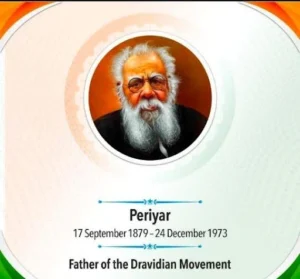
- Vaikom Satyagraha:
-
- Periyar joined the Vaikom Satyagraha in 1924, a movement demanding access to public spaces for lower-caste people.
- He participated in the agitation with his wife and was arrested twice, earning the title Vaikom Veerar (Hero of Vaikom).
-
- Reconstruction of Tamil Identity:
-
- He opposed the caste system, claiming it was brought to the Tamil region by Aryan Brahmins from Northern India.
- Periyar saw the imposition of Hindi by the Congress in the 1930s as part of the Aryanisation process and an attack on Tamil identity.
-
- Dravidian Movement and Dravidar Kazhagam:
-
- Periyar’s Dravidian Movement opposed caste-based oppression and promoted Tamil national identity.
- In the 1940s, he launched the Dravidar Kazhagam, advocating for an independent Dravida Nadu, which included Tamil, Malayalam, Telugu, and Kannada speakers.
-
- Ideas:
-
- Periyar promoted rational thinking and advocated for women’s independence, rejecting the idea that women should only be child-bearers.
- He insisted on equal employment opportunities for women and promoted property and divorce rights through the Self Respect Movement.
- Periyar encouraged people to drop caste suffixes from their names and avoid mentioning caste.
- He organized inter-dining events, where food was cooked by Dalits, in public conferences during the 1930s.
-
- Death and Legacy: Periyar passed away in 1973 at the age of 94, leaving behind a lasting legacy in Tamil political and social life.
Integrated Ocean Energy Atlas
- News: The Indian National Centre for Ocean Information Services (INCOIS) has announced the development of an ‘Integrated Ocean Energy Atlas’ of the Indian EEZ (Exclusive Economic Zone).
- Definition:
-
- The Integrated Ocean Energy Atlas highlights the immense potential of ocean energy resources, covering various forms such as marine meteorological (solar and wind) and hydrological (wave, tide, currents, ocean thermal, and salinity gradients) energy.
- It identifies areas with high potential for energy generation and serves as a vital reference for policymakers, industry stakeholders, and researchers to harness the energy resources within India’s Exclusive Economic Zone (EEZ).
-
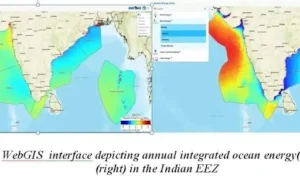
- Ocean Energy Estimation and Visualization:
-
- The Indian National Centre for Ocean Information Services (INCOIS) prepared energy estimates (annual, monthly, and daily) for different ocean energy components using standard methods.
- These estimates can be visualized through a WebGIS interface at a 5 km grid resolution, providing detailed and accessible information.
-
- About INCOIS:
-
- INCOIS was established as an autonomous body in 1999 under the Ministry of Earth Sciences (MoES) and functions as a unit of the Earth System Science Organization (ESSO).
- Its mandate is to provide comprehensive ocean information and advisory services to society, industry, government agencies, and the scientific community through sustained observations and systematic research.
- INCOIS operates the Indian Tsunami Early Warning Centre (ITEWC), providing round-the-clock monitoring and warning services for coastal populations against tsunamis, storm surges, and high waves.
- INCOIS issues daily advisories to fisher folk, helping them locate areas rich in fish resources.
- Short-term (3-7 days) forecasts on ocean conditions such as waves, currents, and sea surface temperature are provided daily to fisher folk, the shipping industry, oil and natural gas companies, the Navy, and the Coast Guard.
-
Battle of Saragarhi
- News: September 12 marked the 127th anniversary of the Battle of Saragarhi, regarded today as one of the finest last stands in global military history.
- Battle of Saragarhi:
-
- The Battle of Saragarhi took place on 12 September 1897 in the North-West Frontier Province (NWFP) of British India, focusing on the Saragarhi post.
- On this day, 21 soldiers from the 36th Sikh Regiment led by Havildar Ishar Singh, along with a non-combatant named Daad, bravely fought against over 8,000 Afridi and Orakzai tribal militants.
- “The 36th Sikhs in the Tirah Campaign 1897-98 – Saragarhi and the Defence of the Samana Forts”, written by military historian Capt Amarinder Singh gives the details of this battle.
-
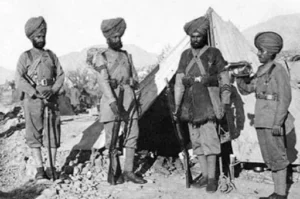
- Remembrance of the Slain Soldiers:
-
- In 2017, the Punjab government declared September 12 as a holiday to observe Saragarhi Day in honor of the fallen soldiers.
- In Pakistan, the Khyber Scouts regiment of the Pakistani army continues to mount a guard and salute the Saragarhi memorial near Fort Lockhart.
- The British, who regained control of the fort days after the battle, built an obelisk in memory of the martyrs using the burnt bricks of Saragarhi.
-
- Significance of Saragarhi Post for the British:
-
- Saragarhi was a critical post between two forts, Lockhart and Gulistan, originally constructed by Maharaja Ranjit Singh during his western campaigns.
- The post held strategic importance for the British, enabling them to monitor movements and threats from Afghan forces.
- It served as a crucial link between Fort Lockhart and Fort Gulistan, both of which housed a large number of British troops in the challenging terrain of NWFP.
-
UPSC GS 2
Smart Precision Horticulture Programme
- News: The Union Ministry of Agriculture is planning a Smart Precision Horticulture Programme under the existing Mission for Integrated Development of Horticulture (MIDH) scheme.
- Smart Precision Horticulture Programme:
-
- The Smart Precision Horticulture Programme leverages advanced technologies such as the Internet of Things (IoT), Artificial Intelligence (AI), drones, and data analytics.
- Its goal is to enhance agricultural production by maximizing resource efficiency while minimizing environmental impact.
-
- Coverage and Beneficiaries:
-
- The programme aims to cover 15,000 acres of land over a five-year period from 2024-25 to 2028-29.
- It is expected to benefit around 60,000 farmers during this time.
-
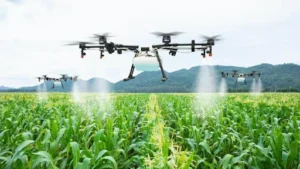
- Funding Support and Collaboration:
-
- The Agriculture Infrastructure Fund (AIF), initiated during the Covid-19 pandemic, includes provisions for financing infrastructure projects that support smart and precision agriculture.
- The Centre is exploring collaboration opportunities with countries like the Netherlands and Israel, where tech-based farming solutions are in use, through Centres of Excellence (CoEs).
-
- Development of Precision Farming Centres:
-
- The government has established 22 Precision Farming Development Centres (PFDCs) across India to test new farming technologies and tailor them to meet local agricultural needs.
- Impacts of Smart and Precision Farming:
- The programme optimizes the use of resources such as water, fertilizers, and pesticides, leading to improvements in both the quality and quantity of production.
- It protects farmers from the uncertainties of climate change and other risks while promoting sustainable farming practices.
-
UPSC GS 3
Centre for Rural Enterprise Acceleration through Technology (CREATE)
- News: Recently, the Union Minister for MSME, Shri Jitan Ram Manjhi inaugurated the Centre for Rural Enterprise Acceleration through Technology (CREATE) setup at Leh through virtual mode.
- Definition & Aim:
-
- The Centre aims to enhance local productivity, improve product quality, and boost economic potential, thereby improving the livelihoods of local communities.
- It seeks to advance rural industrialization and promote enterprise creation, particularly to retain traditional artisans in regions like Ladakh.
-
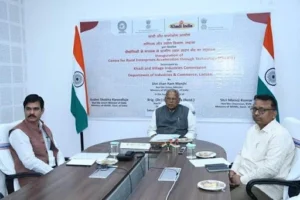
- Key Facilities and Support Provided by CREATE:
- Pashmina Wool Roving Facility: CREATE will provide a dedicated facility for Pashmina wool roving, with machinery already installed, commissioned, and ready for operation.
- Training for Essential Oil Extraction: The Centre will offer training to develop a production facility for essential oil extraction from roses and other flowers.
- Training for Bio-Processing: CREATE will provide training to develop a production facility for bio-processing of locally available fruits and other raw materials.
- Pashmina Wool:
-
- Pashmina is the finest animal fibre derived from the hair of domesticated goat Capra hircus indigenous to Asia.
- The major fibre producing countries are China, Mongolia, Iran, Afghanistan, Pakistan, Nepal, and India.
- China is the major producer of pashmina with the share of 70% followed by Mongolia with 20% share.
- The rest 10% of the total production is from other countries including India, which produces less than 1% of the total production.
- In India, two pashmina producing goat breeds are found i.e. Changthangi and Chegu.
- Changthangi breed is domesticated in Ladakh region of Jammu and Kashmir and Chegu in Himachal Pradesh and Uttrakhand.
- The changthangi area, producing the majority of Indian pashmina, is situated at 3000 to 5000 m above sea level. The area is extremely arid with very low humidity and rainfall. The temperature in these areas ranges from -40°C to +40°C.
- In India, bulk of pashmina fibre is used for the manufacture of shawls, mainly in Kashmir valley.
- The processing of pashmina involves lot of labour in sorting, spinning, weaving and dyeing which are usually done manually.
- The shawl made of pashmina with intricate and unique designs, with the help of local sticks (Kani) using hand jacquard is known as Kani shawl.
- Recently, these hand-woven pashmina shawls have received a Geographical Indication (GI) for its unique nature.
-
Invest India
- News: The Commerce and Industry recently announced the Centre’s Start-up India initiative will be moved out of Invest India to a new non-profit company that could also house the National Start-up Advisory Council.
- Invest India: Invest India is the National Investment Promotion and Facilitation Agency of India, serving as the first point of contact for investors looking to explore opportunities in the country.
- Establishment and Purpose:
-
- Set up as a non-profit venture under the Department for Promotion of Industry and Internal Trade (DPIIT), Ministry of Commerce and Industry, Government of India, Invest India plays a crucial role in promoting investments under the ‘Make in India’ initiative.
- The agency is dedicated to facilitating, empowering, and supporting investors in establishing, operating, and expanding their businesses in India.
-
- Sector-Specific Focus and Partnerships:
-
- Invest India focuses on sector-specific investor targeting and fosters partnerships to attract sustainable investments.
- The agency actively collaborates with investment promotion agencies and multilateral organizations to enhance investment opportunities.
-
- Comprehensive Support for Investors:
-
- Expert Guidance: Invest India offers domain and functional experts who provide sector- and state-specific inputs and assist investors throughout the investment process, from pre-investment decision-making to post-investment support.
- Range of Services: The agency provides comprehensive services, including market entry strategies, in-depth industry analysis, partner search, location assessments, and policy advocacy with key decision-makers.
-
- Headquarters: Delhi.
- National Start-up Advisory Council:
-
- The National Startup Advisory Council (NSAC) was constituted by the Department for Promotion of Industry and Internal Trade (DPIIT) under the Union Ministry of Commerce and Industry.
- Its primary aim is to advise the government on strategies to build a robust ecosystem for nurturing innovation and startups, driving sustainable economic growth, and generating large-scale employment opportunities.
- Composition of NSAC:
- Chairman: The Minister for Commerce & Industry serves as the Chairman of the council.
- Ex-officio Members: Nominees from relevant Ministries, Departments, and Organisations (not below the rank of Joint Secretary) act as ex-officio members.
- Non-official Members: These include founders of successful startups and industry veterans who have scaled companies in India, representing key stakeholders in the startup ecosystem.
- The NSAC is unique in its approach, where the policy-making process is driven through collaboration between all key stakeholders of the startup ecosystem.
- NSAC plays a pivotal role in identifying areas for intervention to expand the startup ecosystem. It also ideates and nurtures national programs under the Startup India initiative.
-
Read also: India-UAE: A Strong Partnership Explore Trade, Investment | UPSC
Syntretus Perlmani
- News: Researchers have recently discovered a new species of parasitoid wasp, Syntretus perlmani, that matures inside living adult fruit flies before dramatically emerging, reminiscent of scenes from the Alien films.
- Syntretus Perlmani:
-
- Syntretus perlmani is a newly identified species of parasitoid wasp.
- Unlike related wasps that typically infect the larval and pupal stages of flies, S. perlmani is the first wasp found to specifically target adult fruit flies.
- These wasps are considered parasitoids rather than parasites because they always kill their hosts, unlike parasites that generally leave their hosts alive.
- Female S. perlmani wasps use a specialised organ called an ovipositor to inject their eggs directly into the abdomen of adult fruit flies.
-
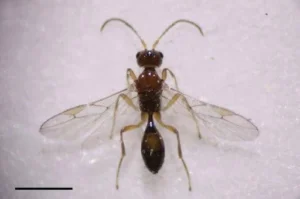
- Life Cycle and Host Impact: Over the course of 18 days, the eggs develop into larvae, growing inside the host fruit fly until they ultimately kill the fly by emerging from its body.
- Distribution: Researchers have found evidence of Syntretus perlmani in various locations across the eastern United States, including Mississippi, Alabama, and North Carolina.

